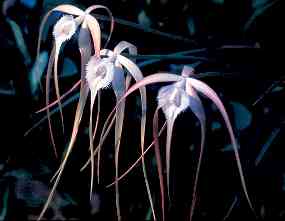Research and Conservation in Southern Sonora, Mexico
Brassavola cucullata
This is one of numerous species of plants including two orchids that are known in Sonora only from Arroyo Verde northeast of Alamos. This canyon and the adjacent Santa Bárbara Canyon support what may be the northernmost semievergreen tropical forest in Mexico.
 Brassavola cucullata flowering in cultivation. Provenance unknown, but probably from Central America. Photo: Mark Dimmitt |
Long, pendulous, very thin terete leaves arise from tiny pseudobulbs and a short, creeping rhizome. (Plant resembles a very skinny Oncidium cebolleta.) The spidery white flowers bloom in summer and are fragrant at night; pollinated by moths.
Several large colonies on huge, shaded boulders in a large riparian canyon in oak forest, 1060 m. In Sonora rare and known from a single locality in the same canyon system and similar in habitat to that where Cattleya (Guarianthe) aurantiaca was found. SE Sonora to Central America, and West Indies. From central Sinaloa southward it is a common epiphytic orchid.
Description: Lithophytic (ours), forming dense colonies to 40 cm across with short rhizomes. Pseudobulbs 8-15 cm long, 2-3 mm diameter, terete, stick-like, not succulent. Leaves single, 18.3-25.7 cm long, 4.6-6.5 mm wide, linear-subulate terete with a broad, shallow dorsal groove, green and fleshy, evergreen. Flowers on peduncles ca. 1 cm long (appearing sessile or subsessile), showy, fragrant, white and spidery, the pedicellate ovary 15.3-23 cm long [ ovary basal, the upper part a hollow nectary -check ours], the sepals 7.5 cm long, the lateral petals 6.4-7.5 cm long, the lip petal 5.4-6.5 cm long, the column 13.3 mm long. Flowering in cultivation August to October.